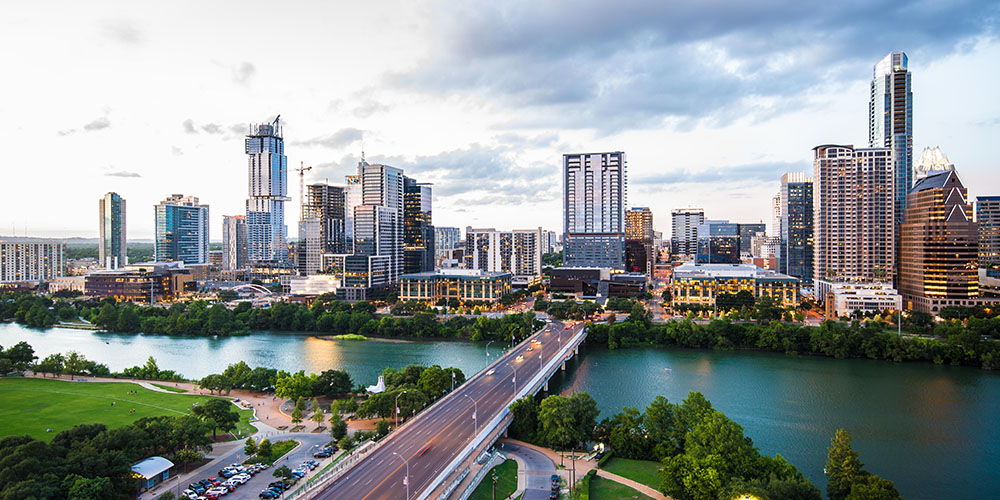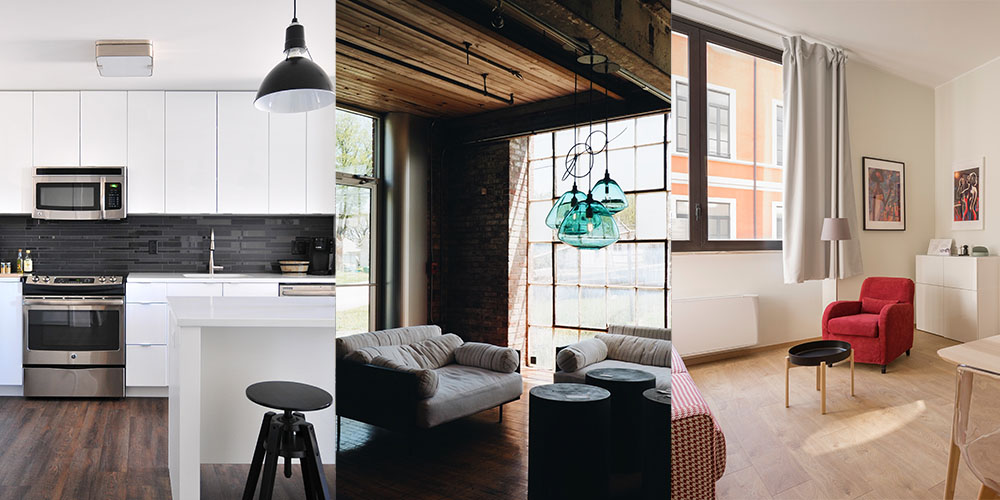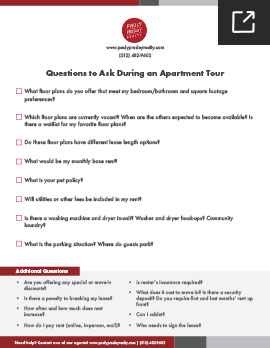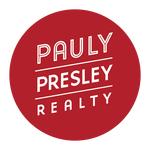The Ultimate Guide to Austin Apartment Hunting
In This Article


Where to Start
Location, Location, Location!
Which Austin Neighborhood Best Fits Your Needs and Lifestyle?
When it comes to apartment hunting, location is just as important as an apartment’s amenities and floor plan. That’s especially true when it comes to finding an Austin apartment, as Austin is a thriving city that’s surrounded by charming suburbs. The metropolitan area has something to offer for a wide range of lifestyles, but it’s up to you to decide which one you want to live in based on your needs and priorities.
But before diving any deeper into your search, now is the time to ask yourself, “What is most important to me about a location?” Defining your ideal location can be overwhelming, especially when you have a lot of options, so we’ve simplified this essential part of the apartment finding process to just a few easy steps.
Consider Your Budget
Rent should constitute no more than 20%-40% of the money you set aside for your needs category.
Following the 50/30/20 rule is an easy way to think about dividing up your monthly income. According to this rule of thumb, 50% of your paycheck (after taxes) should go to things you need. For the average person, the “needs” category includes rent, utilities, transportation, groceries, clothes, healthcare, and loan payments.
After setting aside 50% of your income for what you need, this leaves 30% of your monthly income for your “wants” and another 20% to save for things you want in the future. Rent should constitute no more than 20%-40% of the money you set aside for your needs category.
Keep this price range in mind during your search for an apartment in Austin, TX, whether you are using a free Austin apartment finder tool on a Realtor website, or working with a local Realtor directly.
Apartments for Rent in Austin, TX Based on Price
Once you have determined your budget, consider areas of town where the average rent price fits your price range. Rental properties in Austin neighborhoods and suburbs tend to reflect specific pricing trends. Proximity and demand are two factors affecting these trends. For example, apartments in downtown Austin are more expensive than apartments in the North Lamar neighborhood (however you can find some relatively cheap apartments in downtown Austin, TX, if you know where and when to look.). In areas of Austin experiencing the highest growth and demand (Riverside being one example), rent may be at higher rates than in other areas. We explain these general trends in more detail later.
Pro tip: If you are using a free apartment finder tool online, search for a specific zip code or neighborhood, and use the “price” search parameter to show only apartment homes in your price range.
If you consult with an Austin Realtor, they will narrow down the results for you, based on your preferences, and provide you with the details you need for easy comparison. The Austin, TX, metropolitan area is dynamic and rapidly changing; the best way to get the most up-to-date information and forecast about pricing in an area is to consult a Realtor.
Calculate Potential Commute Times
You’ve determined your budget, and filtered out any areas outside of your price range. Chances are, you are now considering multiple Austin zip codes and neighborhoods as affordable options. It’s now a good idea to define what you consider to be an ideal commute, and the maximum amount of time you would be willing to spend commuting.
How would you rank an ideal commute in your list of priorities? For some, a dream job or great school is worth a long commute. Others might prioritize a short commute over neighborhood amenities. If you have kids, it might be wise to talk to a Realtor about the best family commuter neighborhoods in Austin, TX.
Either way, as your next step, calculate travel time from your workplace to the zip codes/neighborhoods you are considering. Using Google Maps, you can calculate the time it takes to travel between two places at specific times of the day. You can also look at how travel times are different based on your mode of transportation.
Austin’s Capital Metro provides bus and rail services, and private car, scooter and bike share options are prolific throughout the city. The density of traffic in Austin depends on where you are and the time of day. To learn more about the nuances of commutes within and around Austin, TX, talk with an Austin real estate agent.
Check Out What’s Nearby
Like to cook? Consider how close you’ll be from the nearest grocery store, or do a quick search for “Austin apartments near a grocery store” to find an apartment that’s close to one. Travel often and need to get to the airport several times a month? Consider how far is the drive to the ABIA. Knowing what’s nearby (and what isn’t) can help determine which locations are best for you and your lifestyle, just as much, if not more, than other factors.
On a related note: you should also ask yourself other questions about the location, such as if this particular zip code is mostly residential, retail and commercial, or a mixture? What is the walkability score of the neighborhood? How do schools rank in this district? And, especially, what are the crime rates? Create a list of your desired neighborhood amenities and features, and rank them so you have a clear picture of your top priorities.
In addition to proximity to retail, quality of schools and safety, you might also want to check out what restaurants, bars, music venues, theaters, parks, and places of interest are in the area. Then, expand your search and see what’s within a one, three, and five-mile radius.
Unlike many other big cities, you can’t go anywhere in Austin, TX, that isn’t a short walk or drive from great places to eat, enjoy the outdoors, shop, or experience the cultural arts. But it’s always wise to see what’s available so you can choose an Austin apartment for rent that is close to the attractions and amenities you favor.
Austin Neighborhoods-Affordability
When it comes to rent, Austin zip codes and neighborhoods follow general trends. As can be expected, this means you’ll generally find the most expensive and luxurious apartments in Austin closer to downtown, and west of Interstate 35. In Downtown Austin, TX, monthly rent for a one-bedroom apartment can range from $1,000 to $4,000 or more.
Given the near constant influx of students in the area, apartments for rent near UT Austin are also in high demand. The average rent for a one bedroom apartment here hovers around $1,600 to $2,200. Meanwhile, on the east side of I-35, downtown-adjacent East Cesar Chavez and Holly neighborhoods–as well as Central East Austin–you’ll find Austin apartment rents from around $1,914 for a one bedroom apartment. And, West of Downtown and UT, in the 78703 zip code, as well as the Tarrytown and Clarksville neighborhoods, you can find one bedroom rent prices averaging $2,330 per month.
The most affordable Austin apartments can generally be found in the Northeast, Southeast and North parts of Austin. These areas include established neighborhoods such as North Lamar, Onion Creek, Round Rock, and Colony Park, or the 78724, 78744, 78747, 78752, 78753 zip codes. The average rent for one bedroom apartments in these areas is between $1,042 and $1,600 per month. Rest assured, if you’re looking for affordable apartments in Austin, TX, you can’t go wrong by starting your search in one of these areas.
Austin Entertainment Hubs
Want to live within walking distance or a short drive to Austin’s trendiest and eclectic hotspots? While there are many benefits to renting an apartment in Downtown Austin, the fact that it’s literally jam packed with more restaurants, bars, live music and comedy venues than anywhere else in the city is a HUGE perk. It also takes just fiftenn minutes to walk from one end of downtown to the other (talk about a short commute)! Downtown is home to iconic Sixth and Rainey Streets with their alluring array of beer gardens, bungalow homes turned bars, food trucks and dance clubs.
Living Downtown means you can walk (or scooter!) to your favorite hang-out spots without having to worry about finding or paying for parking–great for bar hopping–making it a hub for some of the best apartments for young professionals). When you want to experience the great outdoors, you can also relax or let off steam with a run down Town Lake Metro park trails, where Downtown meets the Colorado River.
If renting in Downtown Austin is out of your budget, but you still want the downtown living experience, check out The Domain in North Austin. The Domain is a mega office, retail, entertainment, residential combo that spans 300+ acres. It’s an outdoor mall mixed in with apartments, green spaces, bars and office buildings, not to mention a Whole Foods!
Don’t want to live in the midst of big city hustle and bustle? Try South or East Austin on for size. Both areas boast live music, unique eats and low-key shops. “Keep Austin Weird” pays homage to the independent and unusual nature of these parts of Austin where old meets new, and BBQ meets vegan. If you love eating and watching movies, spend an evening at dine-in cinema Alamo Drafthouse which also hosts regular interactive events.
Family-Friendly Neighborhoods
Austin is a great place to raise a family, with award winning school districts and low-crime rates. Neighborhood, district, city and state parks are everywhere in Austin, TX, providing safe spaces for play and learning about nature. Many restaurants such as Waterloo Ice-house, Hat Creek Burgers, and Kirby Lane have outdoor playgrounds and games for kids.
According to Niche, a site that uses data to rank neighborhoods, the safest neighborhoods in Austin are Old Enfield, Rosedale, Triangle State, North University and Old West Austin. Rosedale and Allendale, in North Central Austin, are ranked #1 for high quality school districts and crime-rates half the national average. Close by Austin suburbs Rollingwood, Westlake Hills, Round Rock and Leander also boast great test scores, parks, and master planned subdivisions.
High Energy vs Laid Back Austin
Are you an active, busy person or someone who prefers peace and quiet? Perhaps you are a bit of both? Whatever the case, there is an Austin neighborhood for you!
If you like being in the middle of all the action, check out these neighborhoods to ensure you never run out of fun things to do:
- Downtown
- East Cesar Chavez
- North Burnet (The Domain)
- UT - West Campus
- Zilker
- East Riverside/Oltorf area
If you need more time to relax and recharge, consider an apartment for rent in Austin, TX within one of the numerous greenbelts and parks, and farther away from Downtown and entertainment hubs. Start your search in these neighborhoods to get started:
- South Austin (South Lamar, Westgate, Sunset Valley, Menchaca)
- Oak Hill
- Windsor Park (Walnut Creek area)
- Anderson Mill
- Northwest Hills
Looking to be close to entertainment and parks, but also have the option to escape it all? You can find that welcoming, hometown, laid-back feel just a short drive in any direction from Downtown. Check out these neighborhoods for a mix of fun and calm:
- Rosedale, Hyde Park, North Loop
- Allendale
- Mueller
- Cherrywood
- Tarrytown
- Travis Heights
Ready to begin your Austin apartment search? Use our FREE Austin apartment finder to search available apartments for rent or lease in the Austin area.


Narrow Your Search
Refining Your Options
So you’ve found the perfect area of town to live in, or at least a few great options, and you are ready to find the right apartment. Problem is, you now need to begin to narrow down your options–a substantial challenge to say the lease. Fortunately, we’ve got you covered. Follow this step-by-step guide to apartment hunting in Austin to find out what the best Realtors in Austin recommend you do to narrow down your search.
Use Pauly Presley Realty’s Apartment Finder
For the most accurate and up-to-date apartment listings in Austin, skip generic search engines and use Pauly Presley Realty’s Austin apartment finder. Our website features real-time listings pulled directly from the MLS, updated frequently to reflect current availability. Unlike third-party platforms, our listings are curated by local real estate professionals who know the Austin rental market inside and out.
Whether you're looking for a downtown loft, a South Congress studio, or something walkable near UT, our search tool lets you filter by neighborhood, price, amenities, and more—so you can find the perfect apartment faster.
Only See Your Preferences
Real estate search engines offer filter tools so that search results only include those with your preferences. These search filters can include:
- Number of bedrooms and/or bathrooms
- Price range
- Floor (ground, middle, top)
- Apartment features (closets, laundry units)
- Upgrades (balcony, new appliances)
- Community amenities (pool, fitness center, dog park)
- Pets OK
- Proximity to restaurants and shops
- School ratings
- Crime data
- Commute time
By filtering out the apartments that have the amenities you want before you narrow down your search, you can ensure the apartments you find meet all or most of your essential criteria.
Internet-Free Search Methods
Work With An Agent
Apartment finder websites give you a lot of options, but assessing all of those options takes time. If you have a busy schedule, you might consider handing over the search to someone who could make it their full-time job: an Austin real estate agent. Real estate agents can also provide personalized guidance when it comes to finding the right area and type of apartment, based on your specific needs, preferences, and budget.
Looking for condos for rent in Austin Texas? A professional real estate agent can help you find and view these types of properties, as well as vet your potential landlord to ensure they’re up to snuff. Beyond giving renters a leg-up in their search, a real estate agent can also be a powerful asset when negotiating terms. For example, an agent may be able to arrange better lease terms, including help with bad credit and allowing pets.
Access Your Personal Network
Talk to people you know about where they have lived, ask for recommendations and all the details about their experiences. Have those in your immediate circle spread the word that you are looking for a place. Sometimes opportunities occur in the most unexpected ways. There may be someone in your extended network looking to rent a room or in search of roommates in Austin.
Check Out Places With “For Rent” Signs
If you have the free time, stop in at apartment complexes with “Now Leasing” signs or call the phone number on “For Rent” signs in front of other rental properties. In Austin, half of the population lives in Austin rental properties, which means that they are abundant and typically clustered together. You can easily visit multiple apartment complexes, plus get a good feel for an area and its amenities, just by walking, biking, or driving down a few city blocks.
Things to Consider: Apartment Interiors
Multiple Bedrooms vs One Bedroom
When determining your ideal number of bedrooms and bathrooms in an apartment, consider the number of people in your current household, pets, and if you are planning to share the space with a roommate. Ask yourself, “How many bedrooms and bathrooms do I need right now to fit what I already have?” Now, are you looking to expand or downsize? Or has the number of bedrooms in your current living situation been working for you?
Two or More Beds
If you are feeling cramped in your current apartment, want to have your desk in its own office, or need a guest room, you should consider getting an apartment with more bedrooms and bathrooms.
Multiple bedroom floor plans are popular with couples who work from home, have small families, and singles with roommates because they almost always have more than one bathroom. Note that apartments with three or more bedrooms are a bit rare in Austin, though there are options available.
One Bed
If you could live with less space in your new apartment and want to pay less in rent per month, you might consider downsizing to a one bedroom apartment or a studio. One bedroom apartments have walls surrounding a master bedroom and a door for added privacy. They usually come with one bathroom, though they can sometimes include multiple bathrooms or half-baths.
For even more affordability, you can also opt for a studio apartment or loft. Studio apartments are small units with open floor plans. They consist of a single room that combines the bedroom, living room and kitchen spaces with a separate room containing a complete bathroom. Similarly, loft apartments generally have one large, open room with high ceilings.
Square Footage
Make sure to take note of the overall apartment square footage, and the dimensions of the rooms. An apartment may have multiple rooms, but they may not offer enough space to fit your furniture. If you don’t need the extra privacy, sometimes a more open floor plan with fewer bedrooms may actually provide more usable space. Some apartment floor plans might be too open and have wasted space. Visualize how your belongings and your daily life would function in that particular apartment.
Full vs Half Baths
Full-bathrooms have a toilet and shower/bathtub and half-baths only have a toilet. Bathrooms can be attached to bedrooms, meaning their only access is through the bedroom, or can be free standing. Some bathrooms have access from a hallway or another room, as well as through a bedroom.
Open vs Closed Floor Plans
Floor plans in newer apartments are typically more open, and common rooms such as the kitchen and living room seem to flow into each other. Open floor plans will usually have a kitchen that opens into the living room and dining areas with a counter bar or island as the only transitional piece. Other types of floor plans may have galley kitchens which are long and rectangular in shape, with more definition between living room, kitchen and dining areas.
Browse different types of bedroom floor plans before making a decision. Bedroom arrangement in relation to the living room, kitchen and bathrooms can make a big difference in livability. You may want the bedrooms to be right next door to each other, or it may be best to have them separated by the living room or a hallway.
Consider what matters most to you when it comes to apartment features and amenities, as they can make a big difference in whether or not you feel at home in an apartment. Decide what you can’t live with, and what you can’t live without.
- Appliances - refrigerator, dishwasher, garbage disposal, composter
- Laundry
- Washer and dryer provided in-unit
- Hook-ups available in-unit
- Community laundry room
- Kitchen pantry
- Kitchen layout, color of cabinets and counters, sink type
- Bathroom layout and components
- Number of closets (bedroom, linen, coat)
- Flooring type-carpet, tile, vinyl, wood
- Windows-number, size and placement
- Ceiling height
- Balcony/porch
Things to Consider: Large vs Small Complexes
- Cluster of 5-20 (or more) buildings
- Buildings typically have 2-4 stories
- Parking Lot or Garage
- Multiple floor plan options, but repeated throughout complex
- Amenities: pool and fitness center
- On-site maintenance
- Gated or free-entry
- Landscaping
- Typically allow dogs and cats
- Valet Trash (included or additional fee)
- Number of amenities offered for residents is usually higher than at smaller complexes. Can include:
- Resort style pool(s)
- Fitness center, yoga studio
- Walking/biking trails
- Greenspaces
- Dog park(s)
- Dog wash centers
- Volleyball, Basketball courts
- Clubhouse with kitchen, tvs, and games
- Community social events/parties
- Charcoal or gas grills
- Covered parking spots and personal garages
- Valet Trash
- On-site maintenance, landscaping and security
- Background (credit and criminal) checks required for potential tenants
- Electronic mail centers/ package delivery lockers
- Impersonal-with so many residents, individuals can feel like just a number
- Cookie cutter-there is little variation in building architecture and floor plans
- Higher risk of crowds, parking shortages, and noise
Small apartment complexes have no more than five stand alone buildings, and resemble large apartment complexes in every way, but on a smaller scale, which usually means fewer amenities. On the other hand, smaller complexes are typically quieter, and it is easier to get to know your neighbors.
Single building plans have two or more units within a stand alone building. Low rise buildings are most often found in residential areas, and have few levels which means easier street access and no need for elevators. These buildings usually have designated parking for residents. High rise buildings are popular closer to city centers, and can offer great views, and less insects.
Things to Consider: Protective Security Measures
What’s good about gated communities:
- Reduced traffic
- Gates and fences are deterrents for criminals
- No solicitors
- Mechanical malfunctions can block entryways, or leave them open for easy access
- Inconvenient for guests and deliveries
- Gate codes can be given out to anyone
- Doesn’t protect against resident criminal activity
Many of the advantages of having key fobs rather than easy building access are similar to the pros of having a gated community. Key fobs are an added security measure that keeps solicitors and the public out of residential areas. After all, apartment gyms and pools are paid for by residents, and should only be used by the residents or friends/family. With key fobs, management doesn’t have to worry about locking up, and residents can access community buildings after normal work hours. However, residents have to use good judgment in order for the system to actually provide added security. Also, replacing or getting an extra key fob is much more expensive than regular keys.
Things to Consider: Parking Options
Things to Consider: Pet Policies
Leases will likely include a monthly pet fee, and an either refundable or non-refundable “pet deposit” at move-in. There may also be size and weight restrictions for dogs and cats, or a list of “banned dog breeds”. Lease terms may also include vaccination, spay/neutering and leash requirements.
Dog owners are expected to clean up their pet’s excrement, and most apartment complexes have dog waste bag receptacles scattered around the property. Complexes have been known to fine owners caught not cleaning up after their pets, and some even DNA test droppings. Clarify lease terms before signing.
Get personalized guidance and view apartments in person with one of our real estate agents


Final Steps
Tour, Apply, Sign
Take An Apartment Tour and Ask Questions
This is an exciting time in the apartment hunting process! It’s time to narrow down your list of potential apartments to just one. Before committing, ensure it’s a good fit for you by visiting in-person (or virtually), and find out as much as you can about what it’s like to live there. The more details you can capture about different apartments, the easier it will be to distinguish between your options when you compare them later.
Currently living out of town or state? No worries! A real estate agent can be your eyes and ears when it comes to apartment touring, and will represent your interests when communicating with property managers. Using a digital video application, you can accompany a real estate agent on a real-time virtual tour.
Let Your Realtor Handle the Appointment
Your Pauly Presley Realty agent will coordinate with property managers on your behalf to set up tours that match your availability and preferences. This helps streamline communication, avoid long wait times, and ensures you're only touring properties that meet your needs.
Working with a local realtor also gives you access to insider knowledge about floor plans, pricing, and current availability—without the hassle of submitting contact forms or waiting around for callbacks.
Skip the stress and let your agent organize a smooth, efficient apartment tour schedule from start to finish.
What To Ask During The Tour:

Ask these questions first:
- What floor plans do you offer that meet my bedroom/bathroom and square footage preferences?
Ask for floor plan visual print-outs, if they aren’t provided. Apartment complexes sometimes have multiple one and two bedroom floor plans with varying square footage. They may also offer unique bedroom/bathroom combinations. - Which floor plans are currently vacant? When are the others expected to become available? Is there a waitlist for my favorite floor plans?
If there are vacant apartments with your preferred floor plan(s), ask the manager if you can view those apartments specifically. Most likely, apartments with your favorite floor plans will be currently occupied. The community may have a model apartment of your floor plan on the property, or you may not be able to view a life-sized version of the plan. If the tenant has given the manager their move-out notice, you will be given an availability date. There may be a waitlist for units in the apartment complex. While difficult, waitlists are a good sign the complex is in high demand. - Do these floor plans have different lease length options?
Average lease length is typically 12 months. However, shorter or longer leases may be options. Some properties also offer month-to-month rent agreements rather than leases.
For help finding an apartment that offers a month to month lease in Austin, contact an expert Austin Realtor today. - What would be my monthly base rent?
Base rent will depend on lease length and other terms of the agreement. Typically, a shorter lease length will be more expensive than a longer lease. Unit square footage, amenities and location in the complex will also be factors. - What is your pet policy?
If you have a pet, or plan to have one in the future, make sure the complex does not impose any breed restrictions on your pet species or breed. Ask if there will be a refundable or nonrefundable pet deposit(s), and if a pet fee will be added to your rent. - Will utilities or other fees be included in my rent?
Are you responsible for hooking up your utilities and paying for them or is that taken care of by the property manager? Some utilities may be included in your monthly rent, while others are charged separately. Other fees, like valet garbage pick-up and storage, may be included or optional. - Is there a washing machine and dryer in-unit? Washer and dryer hook-ups? Community laundry?
If you’re looking for Austin apartments with a washer and dryer in the unit, you might want to know more about their age, type, and capacity. Some apartments might have space and hook ups for washers and dryers instead. This means that you will need to bring in your own. On the other hand, an apartment complex may have one or more community laundry rooms where you pay for laundry by coin, card or credit. - What is the parking situation? Where do guests park?
Parking is an important consideration if you drive. Fortunately, you can find dozens of Austin apartments with parking throughout the city. Apartment communities may include parking lots or parking garage spaces, or designated, covered spots or private garages may be options for an additional fee. Guests might be able to park in any open spaces, or there may be assigned guest parking, as well.
Ask these questions on the tour:
- How old are the buildings and apartment interiors?
- Are there plans to update the building?
- Can I decorate or paint inside my apartment?
- What maintenance repairs are covered?
- Is there a maintenance team on-site? How do I request maintenance?
- What noise level should I expect from my neighbors? Does the community enforce noise regulations?
- Is there security on-site? Are there security cameras? Do community buildings have key fob entry or access codes? Is the community gated?
- What are the complex amenities? Ask to view them!
- Are there community events?
- What are the rules for guests?
- Is smoking allowed in apartments and on the property?
- How do you control for pests and mold?
- Do you have a bedbug addendum?
Complete the Rental Application
Feeling like it’s a good fit? Go ahead and apply! Just keep in mind that some landlords charge an application fee anywhere between $100-$150+ to cover the cost of the criminal background and credit checks. However, this is not a legally binding document. You will not be committing to anything until you sign the lease or rental agreement.
Application Requirements
- Driver’s license, passport, or other proof of residency
- Proof of income (last 3-6 months pay stubs)
- Social security number (for criminal and credit checks)
- Vehicle registration, proof of insurance
- Rental history and references
Do A Final Walkthrough Inspection:
Ideally, before signing your lease or rental agreement, you will be able to inspect the condition of the actual apartment unit you will be renting/leasing. Often, the unit is occupied when you sign the lease. Either way, be sure to do a thorough walkthrough inspection upon move-in!
Apartment Inspection Checklist
- Are there any signs of pests (ants, roaches, rodents)?
- Check for mold inside bathroom tubs/showers, and under all sinks
- Is there chipping/peeling paint on any interior and exterior walls?
- Are stair, porch and balcony railings secure?
- Check for water damage on ceilings, floors and under sinks
- Test all appliances and fixtures to make sure they are functional and safe
- Stove, microwave, refrigerator/freezer, washer/dryer, electrical outlets, lights, ceiling fans, thermostat
- Sinks, bathtubs and showers, toilets
- Make sure cabinets, doors, and windows open and close properly
- Are smoke and carbon monoxide detectors present?
Get to Know the Lease Terms and Sign
Congratulations! You’ve chosen a floor plan and community, and your application was accepted. You’re in the home stretch, just a few more details to work out. Familiarize yourself with the lease terms, or rental agreement. If you are working with a real estate agent in Austin, they may be able to negotiate some of the lease terms to better suit your needs. Make sure you know the ins and outs of your lease or rental agreement, and then sign away!
Ask These Questions Before Signing:
- Are you offering any special or move-in discounts?
- Is there a penalty to breaking my lease?
- How often and how much does rent increase?
- How do I pay rent (online, in-person, mail)?
- Is renter’s insurance required?
- What does it cost to move in? Is there a security deposit? Do you require first and last months’ rent up front?
- Can I sublet?
- Who needs to sign the lease?
- This includes everyone who is legally liable for rent; you, a spouse or significant other, co-signer (parent/legal guardian), and roommates.
Need help with your Austin Apartment Search? We can help!
Pauly Presley Realty is an Austin-based Realtor service that provides FREE apartment hunting services in addition to our up-to-minute apartment listings website. You can get personalized guidance and view apartments in person with help from one of our professional real estate agents.
We can work with you to ensure you take all of the aforementioned steps to ensure you find and secure the perfect apartment. We can also recommend apartments for rent based on your needs, preferences, and budget–as well as where you want to live and when you want to move. Finally, we’ll even negotiate on your behalf, and work with your landlord or property manager to ensure you get the best deal on your apartment of choice.
To work with Austin’s best apartment hunters, contact the expert Realtors at Pauly Presley Realty today!
